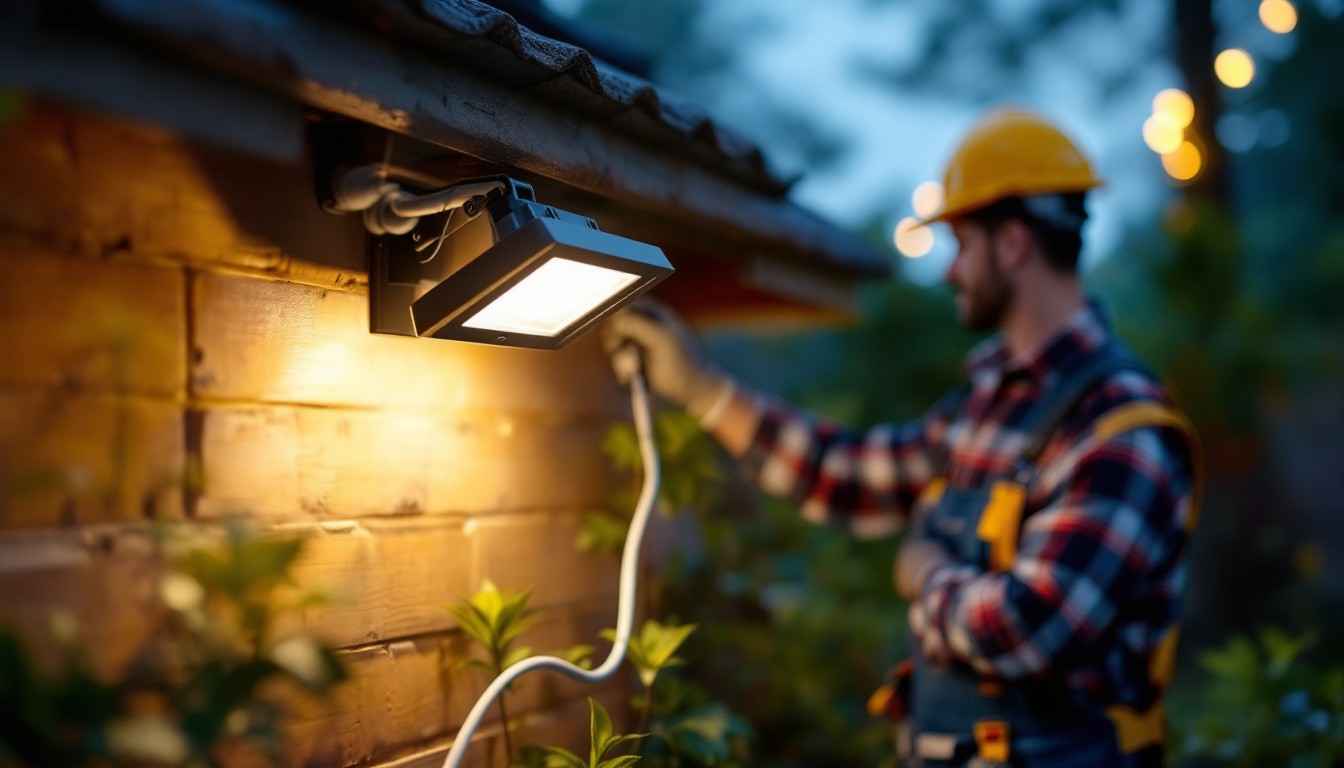
As the demand for sustainable and energy-efficient lighting solutions continues to rise, solar driveway lanterns have emerged as a popular choice among homeowners and contractors alike. These eco-friendly lighting options not only enhance the aesthetic appeal of a property but also provide functional illumination for driveways and pathways. For lighting contractors, understanding the nuances of solar driveway lanterns is essential to delivering quality installations. This article serves as the ultimate checklist for lighting contractors, ensuring that every aspect of solar driveway lanterns is considered for successful projects.
Solar driveway lanterns are outdoor lighting fixtures powered by solar energy. They typically consist of photovoltaic cells that capture sunlight during the day, converting it into electrical energy stored in rechargeable batteries. This stored energy powers the lanterns at night, providing illumination without the need for traditional electrical wiring. The technology behind these lanterns has advanced significantly, leading to improved efficiency and longer-lasting batteries, which means homeowners can enjoy bright, reliable lighting throughout the night.
These lanterns come in various styles, designs, and brightness levels, making them versatile for different landscape aesthetics. From sleek modern designs to classic lantern styles, there is a solar driveway lantern to complement any home. Their installation is generally straightforward, requiring minimal tools and expertise, which makes them an attractive option for contractors looking to offer sustainable solutions. Moreover, many models are equipped with motion sensors, enhancing security by illuminating pathways when movement is detected, which adds an extra layer of safety for homeowners.
One of the primary advantages of solar driveway lanterns is their energy efficiency. By harnessing solar power, these fixtures reduce electricity costs and carbon footprints, appealing to environmentally conscious homeowners. Additionally, they require little maintenance, as there are no wires to check or bulbs to replace frequently. This low-maintenance aspect is particularly appealing for those who prefer a hassle-free outdoor lighting solution, allowing them to enjoy their outdoor spaces without the worry of upkeep.
Another significant benefit is their ease of installation. Unlike traditional lighting systems that may require trenching and complex electrical work, solar lanterns can be placed in desired locations without extensive preparation. This simplicity can lead to quicker project turnaround times and increased client satisfaction. Furthermore, because they are not reliant on the electrical grid, solar driveway lanterns can be installed in remote areas where traditional power sources are unavailable, making them an ideal choice for rural properties or gardens away from the main house.
Solar driveway lanterns come in various types, each suited for different applications and preferences. Path lights, for instance, are typically low to the ground and designed to illuminate walkways, while post lights can be mounted on existing posts or new installations to provide a more elevated light source. Some models even incorporate decorative elements like glass or metal finishes, adding a touch of elegance to the outdoor space while serving a functional purpose.
Additionally, decorative lanterns offer aesthetic appeal, often featuring unique designs that can enhance the overall look of a property. Many homeowners opt for lanterns that reflect their personal style, whether it be rustic, contemporary, or vintage. Understanding the different types available allows contractors to recommend the best options for their clients’ specific needs. Moreover, with advancements in solar technology, some lanterns now come equipped with smart features, such as remote control operation and customizable lighting modes, further enhancing their functionality and appeal in modern landscaping projects.
When installing solar driveway lanterns, several factors should be taken into account to ensure optimal performance and client satisfaction. From site assessment to product selection, each step plays a crucial role in the success of the installation.
A thorough site assessment is essential before installation. Contractors should evaluate the area where the lanterns will be placed, considering factors such as sunlight exposure, existing landscaping, and the intended purpose of the lighting. Areas with ample sunlight throughout the day will yield the best results, as this will maximize the energy collected by the solar panels.
Additionally, it is vital to consider any potential obstructions, such as trees or buildings, that may cast shadows on the lanterns. These obstructions can significantly reduce the amount of sunlight the solar panels receive, leading to diminished performance. Furthermore, the orientation of the driveway itself can influence how much light the lanterns receive; south-facing installations typically receive more sunlight than those facing north. Evaluating the seasonal changes in sunlight can also help in determining the best placement for consistent energy capture throughout the year.
Once the site assessment is complete, selecting the appropriate solar driveway lanterns is the next step. Factors to consider include brightness levels, design styles, and battery capacity. The brightness of the lanterns should match the intended use; for example, brighter lights may be necessary for safety in high-traffic areas, while softer lighting may suffice for decorative purposes.
Contractors should also consider the design of the lanterns in relation to the overall aesthetic of the property. A well-chosen design can complement the architecture and landscaping, enhancing the home’s curb appeal. In addition to aesthetics, durability is another critical factor; lanterns made from weather-resistant materials can withstand harsh conditions, ensuring longevity and reducing maintenance costs. It’s also worth exploring features such as motion sensors or adjustable brightness settings, which can provide added functionality and energy efficiency, catering to the specific needs of the homeowner while maximizing the utility of the solar lanterns.
The installation process for solar driveway lanterns is relatively straightforward, but attention to detail is critical to achieving the best results. Following a systematic approach can help ensure that each lantern is installed correctly and functions as intended.
Before installation, it is essential to prepare the site by clearing away any debris, rocks, or vegetation that may obstruct the placement of the lanterns. This preparation creates a clean and level surface for installation, which is crucial for stability and aesthetics.
Additionally, marking the locations for each lantern can help visualize the layout and ensure even spacing. Contractors should consider the spacing between lanterns carefully, as too much distance can lead to dark spots, while too little can create a cluttered look.
Once the site is prepared, the installation of the lanterns can begin. Most solar driveway lanterns come with straightforward installation instructions, often requiring little more than inserting stakes into the ground or mounting them on posts. It is essential to ensure that the solar panels are oriented toward the sun for optimal energy collection.
After installation, contractors should test each lantern to ensure they are functioning correctly. This step includes checking that the lights turn on at night and that the brightness meets the client’s expectations.
While solar driveway lanterns are generally low-maintenance, regular upkeep can help prolong their lifespan and ensure optimal performance. Educating clients on maintenance practices can enhance their satisfaction and reduce the likelihood of service calls.
One of the simplest yet most effective maintenance tasks is cleaning the solar panels. Dust, dirt, and debris can accumulate on the panels, obstructing sunlight and reducing their efficiency. Contractors should recommend that clients clean the panels periodically, especially after storms or heavy winds.
In addition to the panels, the lanterns themselves should be cleaned to maintain their appearance. A gentle wash with soap and water can remove grime and keep the fixtures looking new.
Despite their reliability, solar driveway lanterns may encounter issues from time to time. Common problems include dim lighting, failure to turn on, or inconsistent performance. Contractors should be prepared to troubleshoot these issues effectively.
For dim lighting, the first step is to check if the solar panels are clean and unobstructed. If they are, it may be necessary to replace the batteries, as they may have reached the end of their lifespan. For lanterns that fail to turn on, checking the switch and ensuring the lantern is receiving adequate sunlight can often resolve the issue.
Effective communication with clients is paramount throughout the installation process. Educating clients about the benefits and maintenance of solar driveway lanterns can foster trust and satisfaction.
Before beginning the installation, it is crucial to set clear expectations regarding the performance and limitations of solar driveway lanterns. Clients should understand that while these fixtures are energy-efficient, their brightness may vary based on weather conditions and sunlight exposure.
Providing clients with a realistic timeline for installation and potential follow-up maintenance can help manage expectations and ensure a positive experience.
After installation, offering guidance on maintenance practices can empower clients to take care of their solar driveway lanterns effectively. Providing a simple maintenance checklist can serve as a helpful reference for clients, ensuring they know how to keep their lanterns in optimal condition.
Encouraging clients to reach out with any questions or concerns can also foster a lasting relationship, leading to potential referrals and repeat business.
Solar driveway lanterns present an excellent opportunity for lighting contractors to offer sustainable, energy-efficient solutions to their clients. By understanding the intricacies of these fixtures, from site assessment to installation and maintenance, contractors can ensure successful projects that meet client expectations.
Utilizing this ultimate checklist will help contractors navigate the complexities of solar driveway lanterns, allowing them to deliver quality installations that enhance the beauty and functionality of outdoor spaces. As the market for solar lighting continues to grow, staying informed and adaptable will be key to thriving in this evolving industry.
Ready to elevate your lighting installations with the most efficient and stylish solar driveway lanterns? Look no further than LumenWholesale. Our commitment to quality and affordability ensures that you have access to the best spec-grade lighting products at wholesale prices. Say goodbye to inflated markups and hello to a vast selection of reliable, high-performance lighting that meets the highest industry standards. Plus, with free shipping on bulk orders, you can stock up on premium lighting solutions without worrying about hidden fees. Make your next project shine with the perfect blend of quality, affordability, and convenience at LumenWholesale. Discover our unbeatable deals and enhance your outdoor spaces today by visiting Wholesale Lighting at the Best Value.

Discover how lighting contractors can enhance their profitability with diverse light switch options.

Discover how solar power wall mount lights are revolutionizing the lighting industry for contractors.

Discover the ultimate guide to perfecting theater room lighting with our essential checklist tailored for lighting professionals.

Discover why flood lights with outlets are a game-changer for lighting contractors.